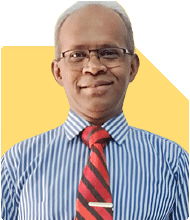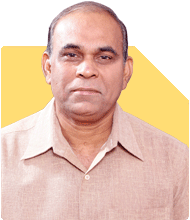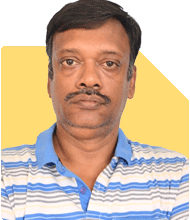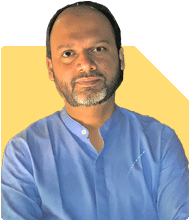Ramalingam Kalirajan |10881 Answers |Ask -Follow
Mutual Funds, Financial Planning Expert - Answered on Jun 10, 2024
He has an MBA in finance from the University of Madras and is a certified financial planner.
He is the director and chief financial planner at Holistic Investment, a Chennai-based firm that offers financial planning and wealth management advice.... more

Hello Sir, I am an salaried professional, 44 yrs, with monthly income of 2.3L. I have a home loan with EMI of 70k and remaining tenure of 13 yrs. Current investments are 41L in PF, 9L in PPF, 10L balance in savings, 3L in stocks. Almost 80K savings per month after deducing everything required. I want to build a retirement plan fund and fund for child education(25L in next 4 yrs). Please suggest.
Current Financial Overview
Your monthly income is Rs 2.3 lakhs, and you manage to save Rs 80,000 after all expenses. You have a home loan EMI of Rs 70,000 with a remaining tenure of 13 years. Your current investments are impressive:
Provident Fund (PF): Rs 41 lakhs
Public Provident Fund (PPF): Rs 9 lakhs
Savings Account: Rs 10 lakhs
Stocks: Rs 3 lakhs
Given this strong foundation, let's proceed with building a comprehensive financial plan.
Setting Financial Goals
Child’s Education Fund
You aim to accumulate Rs 25 lakhs for your child's education in the next four years. This is a short-term goal, so we need a low-risk investment strategy.
Retirement Fund
You also want to build a retirement corpus. Considering your age, you have around 16-20 years until retirement. This gives us a medium to long-term horizon, allowing for a mix of investment options.
Building the Child’s Education Fund
Systematic Investment Plan (SIP)
One effective way to accumulate the education fund is through a Systematic Investment Plan (SIP) in mutual funds. SIPs allow you to invest a fixed amount regularly, helping in rupee-cost averaging and compounding.
To achieve Rs 25 lakhs in four years, you can start a SIP in debt mutual funds, which are relatively low-risk. Here’s an illustration:
Assuming a conservative annual return of 6%, you would need to invest approximately Rs 50,000 monthly. This calculation is based on the future value of a SIP investment.
Fixed Deposits (FDs)
Fixed Deposits (FDs) offer assured returns and are suitable for short-term goals. You could allocate a portion of your savings into FDs. FDs with cumulative interest options are beneficial as they compound interest over the tenure.
Recurring Deposits (RDs)
Recurring Deposits are another safe investment option. They allow you to save a fixed amount every month, and earn interest on it. RDs are ideal for disciplined saving towards short-term goals.
Equity Mutual Funds
While equity mutual funds are generally considered for long-term goals, including a small proportion in your child's education fund can provide higher returns. This approach is suitable if you have a moderate risk appetite. Allocate about 20% of the investment in equity mutual funds, focusing on large-cap funds to balance risk and return.
Building the Retirement Corpus
Equity Mutual Funds
For your retirement corpus, equity mutual funds are an excellent choice. They offer higher returns over the long term, albeit with higher risk. Given your time horizon, you can leverage the power of compounding.
Systematic Investment Plan (SIP)
Continuing with SIPs in equity mutual funds can help you build a substantial retirement corpus. Diversify your investments across large-cap, mid-cap, and multi-cap funds. This diversification helps in managing risk and optimizing returns.
Public Provident Fund (PPF)
You already have Rs 9 lakhs in PPF. Continue contributing to your PPF account as it offers tax benefits under Section 80C and assured returns. The lock-in period aligns well with your retirement goal.
Employee Provident Fund (EPF)
Your EPF is already substantial at Rs 41 lakhs. This should be continued as it provides a steady return and is a low-risk investment. EPF also offers tax benefits and compounds over time.
Investment Strategies
Asset Allocation
Asset allocation is crucial for balancing risk and returns. Given your age and financial goals, a 60:40 equity to debt ratio is advisable. As you near retirement, gradually shift towards more debt investments to preserve capital.
Regular Reviews
Regular reviews of your investment portfolio ensure it aligns with your goals. Adjustments may be needed based on market conditions and life changes. It is essential to stay informed and proactive.
Avoid Emotional Decisions
Investing should be a disciplined and emotion-free process. Avoid making impulsive decisions based on market volatility. Stick to your financial plan and make changes only after careful consideration.
Emergency Fund
Maintaining an emergency fund is vital. It ensures liquidity during unforeseen circumstances. Ideally, this fund should cover 6-12 months of expenses, including your EMI.
You have Rs 10 lakhs in your savings account. Ensure part of this amount is earmarked as an emergency fund. You can also park this fund in liquid mutual funds for better returns while maintaining liquidity.
Tax Planning
Efficient tax planning helps in maximizing your savings. Utilize Section 80C deductions fully by investing in PPF, EPF, and ELSS (Equity Linked Savings Scheme). ELSS funds have a lock-in period of three years and provide tax benefits along with equity returns.
Section 80D allows deductions for health insurance premiums. Ensure you have adequate health coverage for your family. Premiums paid towards health insurance policies can help in reducing your taxable income.
Child’s Education Fund: Investment Mix
Debt Mutual Funds
Debt mutual funds are suitable for your child’s education fund due to their lower risk compared to equity funds. They invest in fixed-income securities and offer steady returns.
Sukanya Samriddhi Yojana (SSY)
If you have a daughter, consider the Sukanya Samriddhi Yojana. It offers attractive interest rates and tax benefits. SSY is specifically designed for the education and marriage expenses of a girl child.
National Savings Certificate (NSC)
NSC is a government-backed savings scheme. It offers guaranteed returns and is a safe investment option. NSC investments are eligible for tax deductions under Section 80C.
Equity Mutual Funds
To potentially enhance returns, include equity mutual funds in the mix. Allocate about 20% of the total investment towards large-cap equity mutual funds. They provide growth potential with relatively lower risk compared to mid or small-cap funds. This helps in balancing safety and growth for the education fund.
Retirement Fund: Investment Mix
Equity-Linked Savings Scheme (ELSS)
ELSS funds provide the dual benefit of tax savings and equity returns. They have a mandatory lock-in period of three years, making them suitable for long-term investments.
National Pension System (NPS)
NPS is a retirement-focused investment option. It offers market-linked returns and tax benefits under Section 80CCD. NPS allows partial withdrawals for specific purposes like children’s education and buying a house.
Monitoring and Adjustments
Annual Portfolio Review
Review your investment portfolio annually. Assess the performance of your investments and make necessary adjustments. This helps in staying on track with your financial goals.
Rebalancing
Rebalancing involves realigning the weightings of your portfolio. It helps in maintaining your desired asset allocation. Rebalancing is essential to manage risk and optimize returns.
Risk Management
Insurance Coverage
Ensure you have adequate life and health insurance coverage. Term insurance provides financial protection to your family in case of an untimely demise. Health insurance covers medical expenses and safeguards your savings.
Diversification
Diversification reduces risk by spreading investments across different asset classes. It ensures that poor performance in one investment does not significantly impact your overall portfolio.
Building Wealth for the Long Term
Compounding
Compounding is a powerful tool in wealth creation. Start investing early and regularly to take advantage of compounding. Reinvesting returns helps in exponential growth of your investments.
Consistency
Consistency in investing is key to achieving financial goals. Regular investments, even in small amounts, contribute significantly over time. Avoid the temptation to time the market.
Behavioral Finance
Avoid Herd Mentality
Investing based on market trends or popular opinion can be detrimental. Make informed decisions based on your financial goals and risk tolerance. Consult with a Certified Financial Planner for personalized advice.
Discipline
Discipline in investing involves sticking to your financial plan. Avoid making changes based on short-term market fluctuations. Regular and disciplined investments yield better results over the long term.
Final Insights
Creating a financial plan requires careful consideration and discipline. By focusing on your child’s education and retirement, you can secure your family’s future. Start with a detailed plan and make regular investments. Monitor your progress and make adjustments as needed.
Your financial journey is unique, and personalized advice from a Certified Financial Planner can further enhance your strategy. Stay committed to your goals and enjoy the financial freedom you deserve.
Best Regards,
K. Ramalingam, MBA, CFP,
Chief Financial Planner,
www.holisticinvestment.in
Regular Savings Increase: With an 8% increase in salary, your monthly savings will also increase. Continuously save and invest a portion of this increment to accelerate wealth accumulation.
Systematic Investment Plan (SIP): Start or increase SIPs in diversified equity mutual funds. With a long investment horizon, equities offer the potential for higher returns. Allocate a significant portion of your savings towards SIPs.
Asset Allocation: Maintain a balanced portfolio with a mix of equity and debt instruments. Initially, you can have a higher allocation towards equities, gradually shifting towards debt as you near the goal to mitigate risk.
Review and Rebalance: Regularly review your portfolio's performance and make adjustments as necessary. Rebalance your investments to maintain the desired asset allocation.
Tax-Efficient Investments: Utilize tax-saving investment options like Equity Linked Savings Schemes (ELSS) and Public Provident Fund (PPF) to optimize tax benefits while building your corpus.
Stay Disciplined: Consistency and discipline are key to achieving long-term financial goals. Stay committed to your investment plan, even during market fluctuations.
By diligently following this plan, leveraging salary increments, and staying invested for the long term, you can aim to achieve your target corpus of 75 lakhs in 15 years.
Best Regards,
K. Ramalingam, MBA, CFP,
Chief Financial Planner,
www.holisticinvestment.in
You may like to see similar questions and answers below
Ramalingam Kalirajan |10881 Answers |Ask -Follow
Mutual Funds, Financial Planning Expert - Answered on Jul 17, 2024
Ramalingam Kalirajan |10881 Answers |Ask -Follow
Mutual Funds, Financial Planning Expert - Answered on Jul 18, 2024
Ramalingam Kalirajan |10881 Answers |Ask -Follow
Mutual Funds, Financial Planning Expert - Answered on Aug 04, 2025
Naveenn Kummar |235 Answers |Ask -Follow
Financial Planner, MF, Insurance Expert - Answered on Sep 18, 2025
Nayagam P P |10854 Answers |Ask -Follow
Career Counsellor - Answered on Dec 14, 2025
Radheshyam Zanwar |6744 Answers |Ask -Follow
MHT-CET, IIT-JEE, NEET-UG Expert - Answered on Dec 14, 2025
Radheshyam Zanwar |6744 Answers |Ask -Follow
MHT-CET, IIT-JEE, NEET-UG Expert - Answered on Dec 14, 2025
Dr Dipankar Dutta |1840 Answers |Ask -Follow
Tech Careers and Skill Development Expert - Answered on Dec 14, 2025
Dr Dipankar Dutta |1840 Answers |Ask -Follow
Tech Careers and Skill Development Expert - Answered on Dec 13, 2025
Dr Dipankar Dutta |1840 Answers |Ask -Follow
Tech Careers and Skill Development Expert - Answered on Dec 13, 2025
Mayank Chandel |2575 Answers |Ask -Follow
IIT-JEE, NEET-UG, SAT, CLAT, CA, CS Exam Expert - Answered on Dec 13, 2025
Radheshyam Zanwar |6744 Answers |Ask -Follow
MHT-CET, IIT-JEE, NEET-UG Expert - Answered on Dec 13, 2025
Mayank Chandel |2575 Answers |Ask -Follow
IIT-JEE, NEET-UG, SAT, CLAT, CA, CS Exam Expert - Answered on Dec 13, 2025
Mayank Chandel |2575 Answers |Ask -Follow
IIT-JEE, NEET-UG, SAT, CLAT, CA, CS Exam Expert - Answered on Dec 13, 2025

























